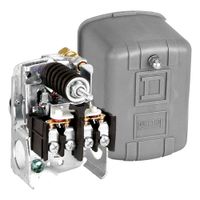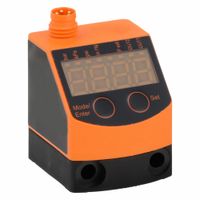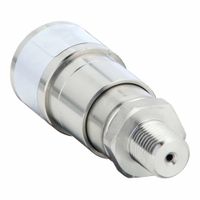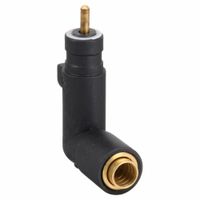Call +(254) 703 030 000 / 751 483 999 / 721 704 777
- Home
- Electrical
- Industrial Controls Automation And Machine Safety
- Pressure Vacuum Switches
.....Read More
Frequently Asked Questions
What is the purpose of pressure, vacuum, and vibration switches in industrial systems?
Pressure, vacuum, and vibration switches are critical components in industrial systems, each serving distinct purposes to ensure safety, efficiency, and operational integrity.
Pressure switches are used to monitor and control the pressure levels within a system. They activate or deactivate a circuit when a set pressure point is reached, ensuring that the system operates within safe pressure limits. This prevents over-pressurization, which can lead to equipment failure or safety hazards. Pressure switches are commonly found in applications like HVAC systems, hydraulic systems, and pneumatic controls.
Vacuum switches function similarly to pressure switches but are designed to monitor and control vacuum levels. They are essential in processes where maintaining a specific vacuum level is crucial, such as in vacuum pumps, packaging machines, and certain chemical processes. By ensuring that vacuum levels remain within specified limits, these switches help prevent system inefficiencies and potential damage to equipment.
Vibration switches detect abnormal vibration levels in machinery and equipment. Excessive vibration can indicate mechanical issues such as imbalance, misalignment, or bearing failures. Vibration switches trigger alarms or shut down equipment when vibration exceeds predetermined thresholds, preventing further damage and reducing downtime. They are vital in industries like manufacturing, where machinery health is critical to maintaining production efficiency.
In summary, pressure, vacuum, and vibration switches are essential for monitoring and controlling critical parameters in industrial systems. They enhance safety by preventing equipment damage and potential hazards, improve efficiency by ensuring optimal operating conditions, and reduce maintenance costs by enabling early detection of issues.
How do air and water pressure switches prevent overpressure in systems?
Air and water pressure switches are critical components in various systems to prevent overpressure, ensuring safety and operational efficiency. These switches monitor the pressure levels within a system and activate or deactivate equipment based on preset thresholds.
In air systems, pressure switches are often used in compressors. When the air pressure reaches a predetermined maximum level, the switch opens the electrical circuit, stopping the compressor to prevent further pressure buildup. Conversely, when the pressure drops to a minimum threshold, the switch closes the circuit, allowing the compressor to restart and maintain the desired pressure range. This cycling prevents overpressure, which could lead to equipment failure or safety hazards.
Similarly, in water systems, pressure switches are used in pumps and boilers. They monitor the water pressure and control the pump's operation. If the pressure exceeds the set limit, the switch interrupts the power supply to the pump, halting its operation to avoid overpressure. This is crucial in preventing pipe bursts, leaks, or damage to the system components. When the pressure falls below the minimum level, the switch reactivates the pump to restore adequate pressure.
Both air and water pressure switches can be mechanical or electronic. Mechanical switches use diaphragms or pistons to sense pressure changes, while electronic switches use sensors for more precise control. These switches are adjustable, allowing operators to set the desired pressure range according to system requirements.
Overall, pressure switches act as safety devices, automatically regulating system pressure to prevent overpressure conditions, thereby protecting equipment, ensuring safety, and maintaining system integrity.
What are the applications of miniature water and air pressure switches?
Miniature water and air pressure switches are versatile components used in various applications across multiple industries due to their compact size and reliable performance.
1. **HVAC Systems**: In heating, ventilation, and air conditioning systems, these switches monitor and control the pressure of air and refrigerants, ensuring optimal system performance and energy efficiency. They help in maintaining the desired environmental conditions by regulating the compressor and fan operations.
2. **Automotive Industry**: In vehicles, miniature pressure switches are used to monitor tire pressure, ensuring safety and fuel efficiency. They are also employed in engine management systems to monitor oil and fuel pressure, contributing to the vehicle's overall performance and reliability.
3. **Medical Equipment**: These switches are crucial in medical devices such as ventilators and anesthesia machines, where precise air pressure control is vital for patient safety and effective treatment. They ensure the correct delivery of gases and monitor system integrity.
4. **Industrial Automation**: In manufacturing and process industries, miniature pressure switches are used to control pneumatic and hydraulic systems. They help in maintaining the desired pressure levels, preventing equipment damage, and ensuring smooth operation of machinery.
5. **Water Management Systems**: These switches are used in water pumps and filtration systems to monitor and control water pressure, ensuring efficient operation and preventing damage due to overpressure or dry running.
6. **Consumer Appliances**: In household appliances like washing machines and dishwashers, pressure switches regulate water levels and ensure proper functioning by controlling the water inlet and drainage processes.
7. **Aerospace and Defense**: In these sectors, miniature pressure switches are used in various systems to ensure the reliability and safety of operations, such as in fuel systems and environmental control systems.
Overall, the compact design and precise control capabilities of miniature water and air pressure switches make them indispensable in applications requiring reliable pressure monitoring and control.
How do diaphragm pressure and vacuum switches operate?
Diaphragm pressure and vacuum switches operate based on the deflection of a diaphragm, which is a flexible membrane that responds to changes in pressure or vacuum levels. These switches are used to monitor and control pressure in various systems by opening or closing electrical contacts when a set pressure or vacuum level is reached.
In a diaphragm pressure switch, the diaphragm is exposed to the process pressure on one side and atmospheric or reference pressure on the other. As the process pressure increases, it causes the diaphragm to deflect. This deflection is mechanically linked to a set of electrical contacts. When the diaphragm deflects to a predetermined point, it actuates the contacts, either opening or closing the circuit, depending on the switch design. This action can trigger an alarm, activate a pump, or perform other control functions.
Similarly, a diaphragm vacuum switch operates on the same principle but is designed to respond to vacuum conditions. The diaphragm is exposed to the vacuum on one side and atmospheric pressure on the other. As the vacuum level increases, the diaphragm deflects, actuating the electrical contacts at a set vacuum level.
Both types of switches can be adjusted to activate at specific pressure or vacuum levels by changing the tension on a spring that opposes the diaphragm's movement. This adjustability allows for precise control in various applications, such as HVAC systems, hydraulic systems, and industrial processes.
Diaphragm switches are valued for their simplicity, reliability, and ability to operate without an external power source, making them suitable for a wide range of applications where monitoring and control of pressure or vacuum are critical.
What advantages do digital pressure and vacuum switches offer?
Digital pressure and vacuum switches offer several advantages:
1. **Precision and Accuracy**: Digital switches provide highly accurate readings and control, reducing errors associated with analog systems. This precision is crucial in applications requiring exact pressure or vacuum levels.
2. **Programmability**: They allow for easy programming and adjustment of setpoints, hysteresis, and other parameters, offering flexibility to adapt to different operational requirements without physical modifications.
3. **Real-time Monitoring**: Digital switches often come with displays that provide real-time data, enabling operators to monitor system status instantly and make informed decisions quickly.
4. **Data Logging and Communication**: Many digital switches can log data and communicate with other systems via protocols like Modbus, enabling integration into larger control systems for comprehensive monitoring and analysis.
5. **Durability and Reliability**: Digital switches typically have fewer moving parts than mechanical switches, reducing wear and tear and increasing lifespan and reliability.
6. **Compact Design**: They often have a more compact design, saving space and allowing for easier installation in tight or complex setups.
7. **Energy Efficiency**: Digital switches can be more energy-efficient, as they often require less power to operate compared to their analog counterparts.
8. **Enhanced Safety Features**: They can include advanced safety features such as self-diagnostics and alerts for out-of-range conditions, enhancing system safety and reducing downtime.
9. **User-friendly Interface**: The interface is often more intuitive, with digital displays and touch controls that simplify operation and reduce the learning curve for new users.
10. **Cost-effectiveness**: Over time, the reduced maintenance, increased efficiency, and enhanced capabilities can lead to cost savings, despite potentially higher initial costs compared to analog switches.
How do industrial machine tool pressure switches function?
Industrial machine tool pressure switches function by monitoring the pressure levels within a system and activating or deactivating electrical circuits based on preset pressure thresholds. These devices are crucial for maintaining safe and efficient operations in various industrial applications.
A pressure switch typically consists of a sensing element, such as a diaphragm, piston, or bellows, which responds to changes in pressure. When the pressure in the system reaches a predetermined set point, the sensing element moves, causing a mechanical linkage to actuate an electrical switch. This switch can either open or close an electrical circuit, depending on the design and application requirements.
The pressure switch is connected to the system via a pressure port, allowing it to measure the pressure of gases or liquids. The set points for activation and deactivation are adjustable, enabling customization for specific operational needs. These set points are often calibrated during installation to ensure accurate performance.
Pressure switches can be either normally open (NO) or normally closed (NC). In a normally open switch, the circuit is open when the pressure is below the set point and closes when the pressure exceeds it. Conversely, a normally closed switch keeps the circuit closed until the pressure surpasses the set point, at which point it opens the circuit.
These switches are used for various purposes, such as controlling pumps, compressors, and alarms, ensuring that systems operate within safe pressure limits. They are designed to withstand harsh industrial environments, with features like robust housings and corrosion-resistant materials to ensure reliability and longevity.
What are the benefits of combining pressure switches and transducers?
Combining pressure switches and transducers offers several benefits, enhancing system performance and reliability.
1. **Comprehensive Monitoring and Control**: Pressure switches provide on/off control by activating at preset pressure points, while transducers offer continuous pressure measurement. Together, they ensure precise monitoring and control, accommodating both discrete and analog needs.
2. **Enhanced Safety**: Pressure switches can act as safety devices, shutting down systems when pressure exceeds safe limits. Transducers provide real-time data, allowing for proactive adjustments to prevent unsafe conditions, thus enhancing overall safety.
3. **Improved System Efficiency**: Continuous data from transducers allows for fine-tuning of system operations, optimizing performance. Pressure switches can trigger specific actions, such as activating backup systems, ensuring efficient operation under varying conditions.
4. **Cost-Effectiveness**: Using both devices can reduce wear and tear on equipment by preventing overpressure conditions and ensuring systems operate within optimal parameters, potentially lowering maintenance costs and extending equipment lifespan.
5. **Redundancy and Reliability**: The combination provides redundancy; if one device fails, the other can maintain system functionality. This dual-layer approach increases reliability and minimizes downtime.
6. **Versatility**: The integration of both devices caters to a wide range of applications, from industrial automation to HVAC systems, offering flexibility in system design and functionality.
7. **Data-Driven Insights**: Transducers provide valuable data for analysis, enabling predictive maintenance and informed decision-making. Pressure switches can complement this by providing critical alerts, ensuring timely interventions.
8. **Simplified Integration**: Modern systems often require both discrete and continuous inputs. Combining these devices simplifies integration into control systems, facilitating seamless operation and communication.
Overall, the synergy between pressure switches and transducers enhances system functionality, safety, and efficiency, making them a powerful combination in various applications.






